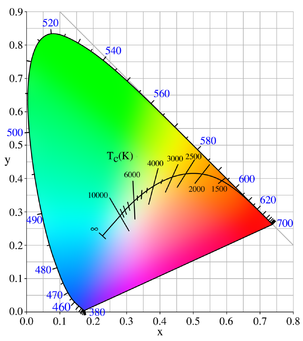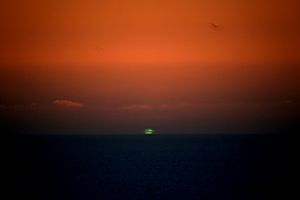Green star (astronomy)
In astronomy, a green star is a white or blueish star that appears greenish in some viewing conditions (see § Psychology below). Under typical viewing conditions, there are no greenish stars, because the color of a star is more or less given by a black-body spectrum.[1] However, a few stars appear greenish to some observers in certain viewing conditions—for example, the optical illusion that a red object can make nearby objects look greenish (and vice versa). Some multiple star systems, such as Antares, have a bright reddish or yellowish star where this contrast makes other stars in the system seem greenish.[citation needed]
Psychology of color perception [edit]
Color is not a fundamental property; it results from the observer's color vision. Thus, no star really has any color at all. Stars emit energy at many different wavelengths, and humans may perceive color in stars. Instead of talking about the "true" color of stars, we must talk about how a particular object appears to a particular observer in a particular context.
This issue is not mere semantics: Green can be perceived when there is no green light at all—the perception may be due, for example, to the simultaneous color contrast[2][3] alluded to above, in that a star can look greenish when it is next to a reddish star (likewise, the reddish star will appear redder when next to a non-reddish star). Green percepts can also be created by blocking red light and by adapting the red photoreceptors (see complementary colors). This is not an illusion; this is simply how humans perceive color.
The perception of color in stars is complicated by the fact that the cone photoreceptors from which color percepts are typically generated are not active in the dim lighting conditions required to see most stars without magnification—that is, in scotopic vision. Furthermore, stars are effectively single points of light at vast distances from the observer's eye; this light is filtered through the atmosphere, pollution, the eye, and the brain. It is only because starlight is split and scattered or because the observer's eye is always moving that the light from a star can stimulate multiple photoreceptors in the retina and thereby generate percepts of color relative to the background illumination.[citation needed]
The Planckian Locus and its effect on the perceived color of stars[edit]


A star is usually close to being a black body, give or take a few spectral lines, so its color is usually more or less the color of a black body. The color of a black body lies on the Planckian locus in the middle of the diagram shown here. As can be seen, this locus happens to pass through red, orange, yellow, white, and light blue areas, and one can indeed see many stars of these colors. On the other hand, it does not pass through green, indigo (dark blue) or violet areas, so stars that appear to have these colors are rare and depend on some additional optical effect.[4]
The black body colors of stars are sometimes confused with the colors of the spectrum.[citation needed] The spectral (rainbow) colors are those on the curved part of the boundary of the diagram on the right. As can be seen, the red, orange, yellow, and blue rainbow colors happen to be much the same as black body colors, which range from pale cyan, to white, to yellow, to orange. However, stars whose peak emission is green light (around 6000K, similar to the Sun) also emit a great deal of both red and blue light,[citation needed] and the human visual system interprets this mixture of colors as whitish rather than green. To be seen as green by a human, an object needs to have a strong emission peak in the middle of visible light spectrum, with little to no spectral red and blue "wings". Objects radiating in blackbody spectrum does not possess indicated properties.
So the fact that some spectral colors appear as star colors is more a quirk of human color vision than a property of stars: If one uses an instrument such as a spectroscope that is better at distinguishing wavelengths of light, then the separated spectral colors look different from the composite colors of stars.[citation needed]
All sufficiently hot stars look blue-white and not violet as claimed by some popular accounts. At sufficiently large temperatures above approximately 20,000 K, all black body spectra appear similar in the visible spectrum, however they can differ much at shorter wavelengths.[citation needed] Although their maximum output at visible wavelengths is at violet, they put out enough light at other wavelengths to look light blue, as described by the Planckian locus.
Objects that resemble green stars[edit]
Although there are no truly green stars, there are many astronomical objects that can sometimes appear to be green stars. This section lists some of them.
Beta Librae[edit]
— R. Burnham, Jr. (1978)[5]
The star Beta Librae (Zubeneschamali, β Lib) is usually described as appearing white to modern observers, viewed through modern telescopes.[6] However, its color is controversial, and many earlier observers stated that they saw it as green.[5] There seems to be no consensus about what its color really is, and no generally accepted explanation for why some observers have seen it as green.[7]
Multiple stars[edit]
— Elias Loomis (1877)[8]
There are a few stars in double or multiple star systems that appear greenish, even though they are blue or white under typical viewing conditions. This can happen if the star system contains a large red or orange star.[8] Color contrast effects cause objects close to the reddish star to appear slightly greenish (and vice versa: complementary colors).

- Antares
The classical example is Antares (Alpha Scorpii or α Sco), the brightest star in the constellation Scorpius: The primary of the double star system is the red supergiant primary α Sco A; it has a blue companion α Sco B. When viewed at low-enough power so that the light of the two stars is seen combined, some observers describe the color as greenish.[9]
- Almach
Other examples include the star system Almach (γ¹ and γ² Andromedae) a golden-yellow star next to a dimmer, indigo-blue star[10] about 350 light years away.

- σ Cassiopeiae
Another is the Sigma Cassiopeiae (σ Cas) star system, a binary star 1,500 light-years from Earth. σ Cas‑A is a greenish-hued magnitude 5.0 primary, next to magnitude 7.3 blue-hued secondary σ Cas‑B.[11]
Planetary nebulae[edit]
Some planetary nebulae themselves glow with the green OII emission lines, especially if the nebula is enriched oxygen, well irradiated by its central late-stage star or white dwarf. These nebulae, or the stars within them (usually bluish or white Wolf-Rayet stars) may appear to be green when viewed in combination at low power.[citation needed] Some examples are the planetary nebulas NGC 6572, NGC 6826, and NGC 7009.[citation needed]
Uranus[edit]

The planet Uranus occasionally appeared in ancient star catalogs, and in more recent catalogs before William Herschel discovered that it is a planet—most recently as 34 Tauri in Flamsteed's catalog. It appears as a small greenish dot in binoculars. The color is from its cold methane atmosphere.[citation needed]
The Sun[edit]

The Sun can sometimes appear as a green spot for a second or two as it is rising or setting: this is known as green flash. Roughly speaking, the red light from the Sun is blocked by Earth, the blue light is scattered by the atmosphere, and the green light is refracted by the atmosphere to the observer.[12]

A similar effect can occasionally be seen with other astronomical objects such as the moon and bright planets.[citation needed]
Furthermore, the Sun emits more green photons than any other color; i.e., it peaks in the green part of the visible spectrum.
False color images[edit]
Astronomical images are sometimes printed in false colors, which can make stars look green.
See also[edit]
References[edit]
- ↑ Cain, Fraser (10 February 2009). "Are there Green Stars?". Universe Today – space and astronomy news. Retrieved 27 August 2017.
- ↑
Daw, Nigel W. (17 November 1967). "Goldfish retina: Organization for simultaneous colour contrast". Science. 158 (3803): 942–944. Bibcode:1967Sci...158..942D. doi:10.1126/science.158.3803.942. PMID 6054169. Unknown parameter
|s2cid=ignored (help) - ↑
Conway, Bevil R. (2002). Neural Mechanisms of Color Vision: Double-opponent cells in the visual cortex. Springer. ISBN 978-1-4020-7092-1 – via Google Books. Search this book on

- ↑
"Gröna stjärnor? Varför finns det inga gröna stjärnor?" [Green stars? Why are there no green stars?]. Allt om Vetenskap [All about Science] (in svenska). No. 2. 9 October 2012. Archived from the original on 28 August 2017. Retrieved 27 August 2017. Unknown parameter
|url-status=ignored (help) - ↑ 5.0 5.1
Burnham, Robert (1978). Burnham's Celestial Handbook: An observer's guide to the universe beyond the solar system. 2 (Reprint ed.). New York, NY: Dover. p. 1105. ISBN 9780486235684. Retrieved 26 August 2017 – via Google Books. Search this book on

- ↑ "* bet Lib – variable star". SIMBAD. Basic data. Centre de Données astronomiques de Strasbourg. Retrieved 20 May 2015.
- ↑
Kaler, James B. (2006). "Zubeneschamali". Astronomy (personal academic site). Stars. University of Illinois. Archived from the original on 14 July 2006. Retrieved 26 August 2017. Unknown parameter
|url-status=ignored (help) - ↑ 8.0 8.1
Loomis, Elias (1870). A Treatise on Astronomy. New York, NY: Harper and Brothers. p. 299 – via Internet Archive (archive.org). Search this book on

- ↑
Schaaf, Fred (1983). Wonders of the Sky: Observing rainbows, comets, eclipses, the stars, and other phenomena. Courier Corporation. p. 213. ISBN 9780486244020. Retrieved 7 September 2017 – via Google Books. Search this book on

- ↑
Burnham, Robert (1 January 1978). "Andromeda-Cetus". Burnham's Celestial Handbook: An observer's guide to the universe beyond the solar system. Courier Corporation. ISBN 978-0-486-23567-7.CS1 maint: Date and year (link) Search this book on

- ↑ Mason, Brian D.; Wycoff, Gary L.; Hartkopf, William I.; Douglass, Geoffrey G.; Worley, Charles E. (2001). "The 2001 US Naval Observatory Double Star CD-ROM. I. The Washington Double Star Catalog". The Astronomical Journal. 122 (6): 3466. Bibcode:2001AJ....122.3466M. doi:10.1086/323920.
- ↑ Young, Andrew T. "Explaining green flashes". San Diego, CA: San Diego State University. Retrieved 26 August 2017.
Sources[edit]
- Burnham, Robert (1978). Burnham's Celestial Handbook: An observer's guide to the universe beyond the solar system (reprint ed.). New York, NY: Dover. ISBN 978-048623568-4 – via Google Books. Search this book on

External links[edit]
- Plait, Phil (2008-07-29). "Why are there no green stars?". Bad Astronomy. Slate Magazine (blog).
Others articles of the Topic Spaceflight : Universe
This article "Green star (astronomy)" is from Wikipedia. The list of its authors can be seen in its historical and/or the page Edithistory:Green star (astronomy). Articles copied from Draft Namespace on Wikipedia could be seen on the Draft Namespace of Wikipedia and not main one.
